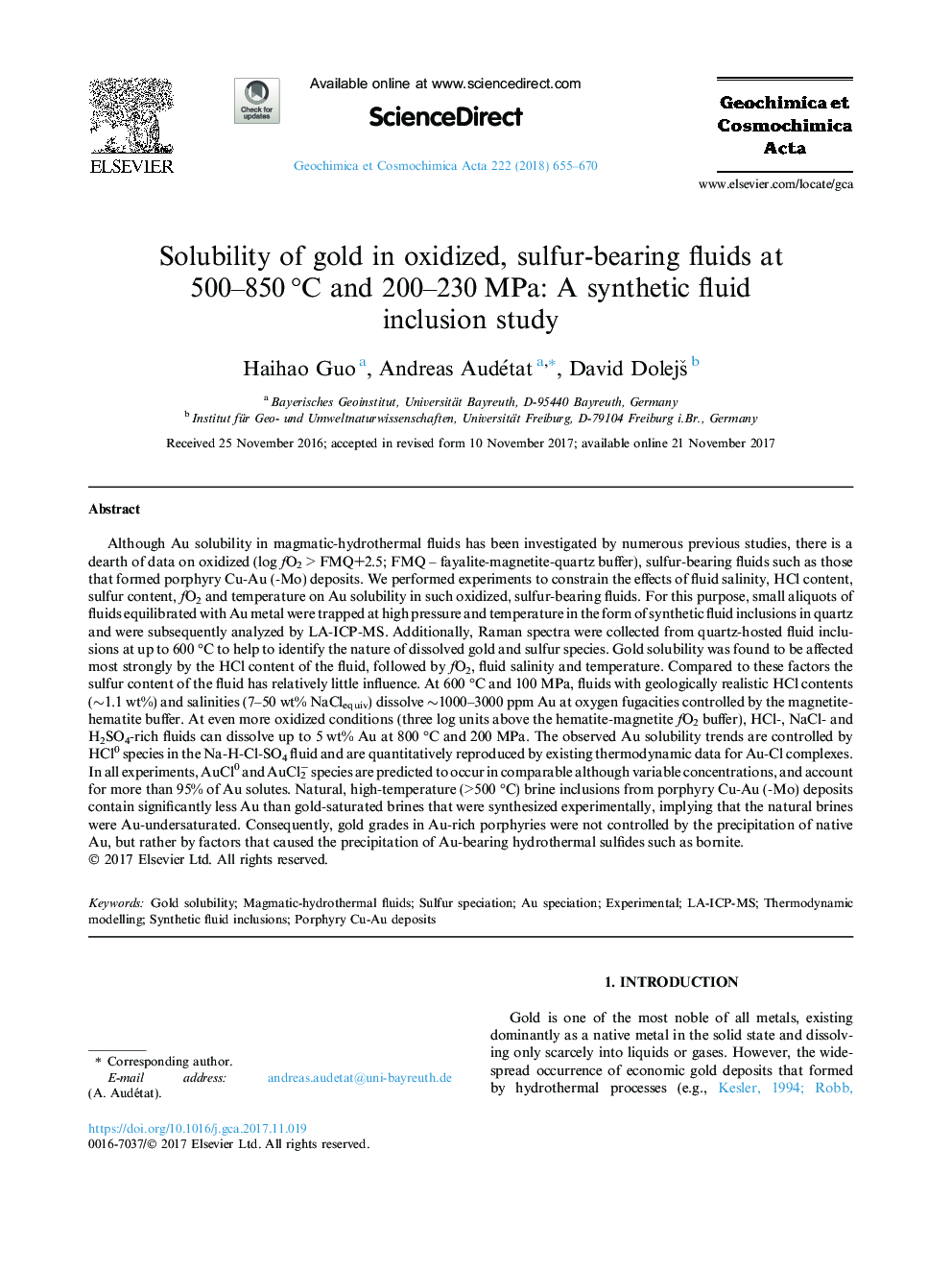| کد مقاله | کد نشریه | سال انتشار | مقاله انگلیسی | نسخه تمام متن |
|---|---|---|---|---|
| 8910971 | 1637935 | 2018 | 16 صفحه PDF | دانلود رایگان |
عنوان انگلیسی مقاله ISI
Solubility of gold in oxidized, sulfur-bearing fluids at 500-850â¯Â°C and 200-230â¯MPa: A synthetic fluid inclusion study
دانلود مقاله + سفارش ترجمه
دانلود مقاله ISI انگلیسی
رایگان برای ایرانیان
کلمات کلیدی
موضوعات مرتبط
مهندسی و علوم پایه
علوم زمین و سیارات
ژئوشیمی و پترولوژی
پیش نمایش صفحه اول مقاله

چکیده انگلیسی
Although Au solubility in magmatic-hydrothermal fluids has been investigated by numerous previous studies, there is a dearth of data on oxidized (log fO2â¯>â¯FMQ+2.5; FMQ - fayalite-magnetite-quartz buffer), sulfur-bearing fluids such as those that formed porphyry Cu-Au (-Mo) deposits. We performed experiments to constrain the effects of fluid salinity, HCl content, sulfur content, fO2 and temperature on Au solubility in such oxidized, sulfur-bearing fluids. For this purpose, small aliquots of fluids equilibrated with Au metal were trapped at high pressure and temperature in the form of synthetic fluid inclusions in quartz and were subsequently analyzed by LA-ICP-MS. Additionally, Raman spectra were collected from quartz-hosted fluid inclusions at up to 600â¯Â°C to help to identify the nature of dissolved gold and sulfur species. Gold solubility was found to be affected most strongly by the HCl content of the fluid, followed by fO2, fluid salinity and temperature. Compared to these factors the sulfur content of the fluid has relatively little influence. At 600â¯Â°C and 100â¯MPa, fluids with geologically realistic HCl contents (â¼1.1 wt%) and salinities (7-50â¯wt% NaClequiv) dissolve â¼1000-3000â¯ppm Au at oxygen fugacities controlled by the magnetite-hematite buffer. At even more oxidized conditions (three log units above the hematite-magnetite fO2 buffer), HCl-, NaCl- and H2SO4-rich fluids can dissolve up to 5â¯wt% Au at 800â¯Â°C and 200â¯MPa. The observed Au solubility trends are controlled by HCl0 species in the Na-H-Cl-SO4 fluid and are quantitatively reproduced by existing thermodynamic data for Au-Cl complexes. In all experiments, AuCl0 and AuCl2â species are predicted to occur in comparable although variable concentrations, and account for more than 95% of Au solutes. Natural, high-temperature (>500â¯Â°C) brine inclusions from porphyry Cu-Au (-Mo) deposits contain significantly less Au than gold-saturated brines that were synthesized experimentally, implying that the natural brines were Au-undersaturated. Consequently, gold grades in Au-rich porphyries were not controlled by the precipitation of native Au, but rather by factors that caused the precipitation of Au-bearing hydrothermal sulfides such as bornite.
ناشر
Database: Elsevier - ScienceDirect (ساینس دایرکت)
Journal: Geochimica et Cosmochimica Acta - Volume 222, 1 February 2018, Pages 655-670
Journal: Geochimica et Cosmochimica Acta - Volume 222, 1 February 2018, Pages 655-670
نویسندگان
Haihao Guo, Andreas Audétat, David DolejÅ¡,